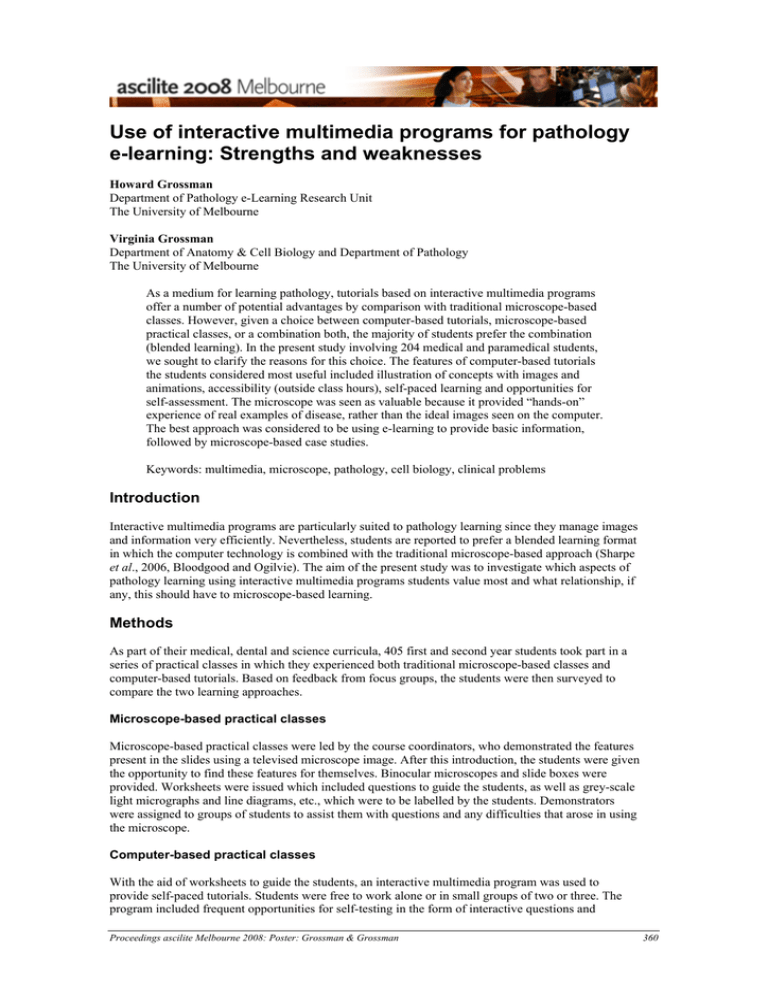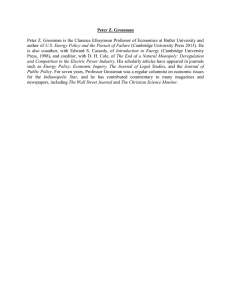Use of interactive multimedia programs for pathology e
advertisement

Use of interactive multimedia programs for pathology e-learning: Strengths and weaknesses Howard Grossman Department of Pathology e-Learning Research Unit The University of Melbourne Virginia Grossman Department of Anatomy & Cell Biology and Department of Pathology The University of Melbourne As a medium for learning pathology, tutorials based on interactive multimedia programs offer a number of potential advantages by comparison with traditional microscope-based classes. However, given a choice between computer-based tutorials, microscope-based practical classes, or a combination both, the majority of students prefer the combination (blended learning). In the present study involving 204 medical and paramedical students, we sought to clarify the reasons for this choice. The features of computer-based tutorials the students considered most useful included illustration of concepts with images and animations, accessibility (outside class hours), self-paced learning and opportunities for self-assessment. The microscope was seen as valuable because it provided “hands-on” experience of real examples of disease, rather than the ideal images seen on the computer. The best approach was considered to be using e-learning to provide basic information, followed by microscope-based case studies. Keywords: multimedia, microscope, pathology, cell biology, clinical problems Introduction Interactive multimedia programs are particularly suited to pathology learning since they manage images and information very efficiently. Nevertheless, students are reported to prefer a blended learning format in which the computer technology is combined with the traditional microscope-based approach (Sharpe et al., 2006, Bloodgood and Ogilvie). The aim of the present study was to investigate which aspects of pathology learning using interactive multimedia programs students value most and what relationship, if any, this should have to microscope-based learning. Methods As part of their medical, dental and science curricula, 405 first and second year students took part in a series of practical classes in which they experienced both traditional microscope-based classes and computer-based tutorials. Based on feedback from focus groups, the students were then surveyed to compare the two learning approaches. Microscope-based practical classes Microscope-based practical classes were led by the course coordinators, who demonstrated the features present in the slides using a televised microscope image. After this introduction, the students were given the opportunity to find these features for themselves. Binocular microscopes and slide boxes were provided. Worksheets were issued which included questions to guide the students, as well as grey-scale light micrographs and line diagrams, etc., which were to be labelled by the students. Demonstrators were assigned to groups of students to assist them with questions and any difficulties that arose in using the microscope. Computer-based practical classes With the aid of worksheets to guide the students, an interactive multimedia program was used to provide self-paced tutorials. Students were free to work alone or in small groups of two or three. The program included frequent opportunities for self-testing in the form of interactive questions and Proceedings ascilite Melbourne 2008: Poster: Grossman & Grossman 360 challenges at the end of each module. Students were required to complete and hand-in a review sheet for each class. The course coordinators were available to answer questions. Survey After obtaining student feedback in focus groups, the study cohort was surveyed and asked to use a 1 – 5 Likert scale to rate the usefulness of the features of the computer-based tutorials identified as important by the groups. Results Computer-based tutorials The computer-based classes were highly successful. Levels of peer interaction were very high and most students were clearly engaged with the material throughout the class. Many students elected to stay beyond the class time to explore the program further themselves. Comments often praised the program as “succinct and clear” or “easy to understand”. Students for whom English was a second language were particularly pleased with these classes as they were able to work through the material at their own pace and were not reliant on hearing the spoken word of the academic-in-charge to learn. All students enjoyed the level of integration of material across disciplines and felt that the program “helped to draw things together”. Survey outcomes The students agreed that the multimedia program significantly enhanced their learning in the subject. When asked to score the statement “The computer-based multimedia program helped me to learn effectively” using a scale of 1 for “strongly disagree” to 5 for “strongly agree”, the mean score was 4.6 ± 0.1. Similarly, they agreed the computer-based tutorials specifically enhanced their understanding of cells, tissues and disease (4.2 ± 0.7). Nevertheless, given a choice of computer-based or microscopebased practical classes or a combination of both, the majority of students preferred the combination (73%, compared with 25% for computer-based tutorials alone and 2% for microscope-based classes alone). Ranked in order, the features of computer-based tutorials considered most useful by students (Table 1) were the illustration of concepts using images and animations, opportunities for revision and flexible access to the program, opportunities for self-testing with provision of rapid feedback, opportunity for self-paced learning, provision of a framework for knowledge, integration of knowledge across disciplines and provision of an alternative way to learn (Table 1). Table 1: Student perceptions of the usefulness of features of the multimedia program Feature Illustration of concepts using images and animations Opportunity for revision Flexible access (outside class hours) Opportunities for self testing Provision of rapid feedback Opportunity for self-paced learning Provision of a framework for knowledge Integration of knowledge across disciplines Provision of an alternative way to learn Response* (Mean ± SD) 4.1 ± 0.9 4.0 ± 0.9 4.0 ± 1.0 4.0 ± 0.9 3.9 ± 0.9 3.9 ± 1.0 3.8 ± 0.9 3.7 ± 1.0 3.6 ± 1.0 (*Mean scores on a 1 – 5 scale, 1 strongly disagree, 5 strongly agree) From their comments, students often experienced some difficulty with using the microscope and felt that demonstrator assistance was important. However, they saw the computer and the microscope as fulfilling two different functions, with the computer assisting learning of basic principles and the microscope showing them examples from real patients. “The computer images are ideal, the microscope shows us the real thing.” The individual variation inherent in the slides was also seen as an important attribute. Proceedings ascilite Melbourne 2008: Poster: Grossman & Grossman 361 “The CALs give us the raw information, the microscopy pracs give us a chance to see for ourselves.” Discussion The findings of the present study confirm the effectiveness of the computer for learning basic principles of pathology. Above all, students value the control the computer gives them over their learning environment, including accessibility to materials enriched with images and animations, control of the pace of presentation of new material and opportunities for revision. The computer manages images and animations efficiently; improves accessibility to material outside class hours and provides rapid feedback on learning. This is particularly useful for pathology, which often requires the use of imageintense resources. At the same time, the findings are consistent with the view that students prefer a learning environment that offers a variety of resources to suit different learning styles (Lujan & DiCarlo, 2006). This supports the proposal that with regard to pathology, the optimum approach may be a blended learning format in which the computer technology is combined with the microscope-based exercises (Sharpe et al., 2006, Bloodgood and Ogilvie). References Bloodgood, RA and Ogilvie, RW (2006).Trends in histology laboratory teaching in United States medical schools, Anat Rec (Part B: New Anat.), 289B, 169–175. Lujan, HL and DiCarlo, SE (2006). First year medical students prefer multiple learning styles. Adv Physiol Educ, 30, 13–16. Sharpe R, Benfield G, Roberts G and Francis R (2006). The undergraduate experience of blended elearning: a review of UK literature and practice. Higher Education Academy, http://www.heacademy.ac.uk/projects/detail/lr_2006_sharpe [viewed 14 May 2008]. Authors: Howard Grossman, Department of Pathology, e-Learning Research Unit, The University of Melbourne, Australia. Email: h.grossman@unimelb.edu.au Virginia Grossman, Department of Anatomy & Cell Biology and Department of Pathology, The University of Melbourne, Australia. Email: v.grossman@unimelb.edu.au Please cite as: Grossman, H. & Grossman, V. (2008). Use of interactive multimedia programs for pathology e-learning: Strengths and weaknesses. In Hello! Where are you in the landscape of educational technology? Proceedings ascilite Melbourne 2008. http://www.ascilite.org.au/conferences/melbourne08/procs/grossman-poster.pdf Copyright 2008 Howard Grossman and Virginia Grossman The authors assign to ascilite and educational non-profit institutions a non-exclusive licence to use this document for personal use and in courses of instruction provided that the article is used in full and this copyright statement is reproduced. The authors also grant a non-exclusive licence to ascilite to publish this document on the ascilite web site and in other formats for Proceedings ascilite Melbourne 2008. Any other use is prohibited without the express permission of the authors. Proceedings ascilite Melbourne 2008: Poster: Grossman & Grossman 362



